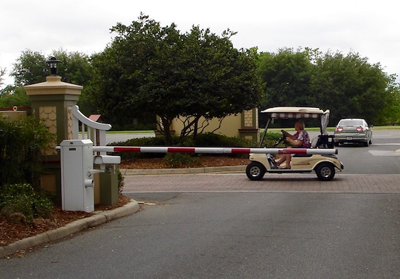Trends That Will Affect Your Driving Habits
The past several months I have been focusing on emerging products and services that may be introduced in your gated or planned community, to include new types of vehicles and charging systems. This article brings together these trends in something of a vision of what lies ahead. In addition, there are interesting infrastructure developments that could well affect not only running your electric-powered golf car, but your air-conditioner as well.
EVBox scores big in California
If you have been reading my column, you may recall that EVBox, a company based in the Netherlands, is a supplier of Level 2 charging systems, both for public, or distributed access, and individual, residential units. The former is installed as part of their BusinessLine system and the latter, their Elvi unit. BusinessLine installations connect directly to the grid, while the Elvi connects to your home circuit panel.
In May of this year, Pacific Gas & Electric Company, serving principally northern and central California, contracted with EVBox to install 2,560 charging systems in their service area. PG&E dubbed their program, the EV Charge Network, and it is aimed at workplaces and multi-unit dwellings. Through the program, PG&E will pay for and build the infrastructure for customers from the electric grid to the charger.
Customers have two options: they can be an EV Charge Owner or an EV Charge Sponsor. For EV Charge Owner projects, customers will own, install and maintain the charging station and receive a rebate for part of the cost. For EV Charge Sponsor projects, PG&E will own, install and maintain the charging station, and customers will pay a participation fee.
The State’s other large investor-owned utilities, San Diego Gas & Electric (SDG&E) and Southern California Edison (SCE), also have partnership programs to install EV infrastructure.
Charging systems are scalable and can diversify your personal transportation system
One thing of critical importance to note is that while California’s major utilities are participating in a state-wide legislative program to provide a charging infrastructure to support 5 million zero emissions vehicles by 2030, it does not take a huge, State-planned system with its various regulatory levels and segments to bring Level 2 charging to your community.
EVBox and other companies have the capacity, as previously noted, to install Level 2 systems on a community-wide or individual residence basis. Thus, if the supervisory board of your gated or planned community wishes, it could invest in a system which collectively serves residents. Alternatively, individual homeowners could install their own systems. Naturally, a key consideration is cost, and another is convenience. access systems probably work better in multi-unit residences and communities that are fully integrated with respect to shopping, recreation, and other amenities.
Another important aspect of Level 2 charging is its ability to charge not only your roundabout golf car, but your out-of-community, that is, your on-road electric vehicle, as well. The majority of gated community residents have two vehicles, the golf car and a conventional vehicle. With the plethora of new electric, on-road models coming on the market and more robust charging systems coming to the fore, the prospect of a one-stop “fill-up” for both vehicles, as well as opportunity charging for both in public access locations, a more diversified and convenient personal utility model is at hand in some places and certainly likely to spread as a general trend in the not-too-distant future.
Speaking of diverse mobility systems, this provides a segue to the “fusion” vehicle; that is, an electric vehicle capable of both driving about the community and the dash-into-town or more distant locations.
The “do-it-all” personal mobility vehicle
There are a number of start-up companies that are pushing the envelop in personal mobility. I mention two here, but there are others that a little bit of browsing would reveal. These are electric vehicles capable of highway speeds, but with the positive attributes of smallness, full automotive features, including advanced electronics, and avant garde styling.
The first example is the Uniti electric vehicle from Sweden. Scheduled for production in early 2019, here are the specs:
Range:
- Up to 300km (190 mile) range (22kWh battery)
- Swappable auxiliary battery to charge in any normal power outlet – enough capacity to drive 30 km (19 miles)
Charging
- Home fast charging (AC) 3hrs 10mins = full charge (300km—190 mile–range)
- DC charging 200km (125 mile) range in 30mins
- Induction charging
- Solar panel roof for trickle-charging
Driving characteristics
- 0-80kmph (50 m.p.h.) in 3.5 seconds in sports mode
- Top speed up to 130kmph (80 m.p.h.)
- Suitable for both city and highway driving
- Electronic steering
- Rated 5 stars for safety by NCPA (European New Car Assessment Program
One additional feature is that the Uniti comes in a 5-passenger model, meaning that it can accommodate a family and/or provide space for luggage or groceries.
The second vehicle is an American-made vehicle from AEV Technologies out of Austin, TX, the 311, a three-wheeler. The specs, as published on the company’s website, are as follows:
- Motor (HP/Kw): 10.9/8.0
- Top speed: 50+ m.p.h.
- Range: 50 miles
- Brakes: Disc
- Automotive standard steering
- Front wheel drive
- Front suspension: Double A-Arm independent
- Rear suspension: Rigid fork, swinging arm
- Length: 122 inches; Width: 56 inches; Height: 66 inches
- Frame: Coated steel
- Payload capacity: Two passengers
The 311 comes fully-enclosed, half-enclosed side panels and open, thus having option of openness that so many of us like in our golf cars.
Advances in mobility: The secret is in the mix
As a final note, major advances in personal mobility will come about as a combination of initiatives and programs, a significant number of them driven by legislation and utility participation. Basic to everything else is the establishment and spread of an electrification infrastructure, based on grid-connected charging systems (Level 2 and above). And remember that the seed bed of major growth could well be individually and community based systems.
Battery technology, which is not covered in this article, will play a significant role, both as a component of the vehicle’s powertrain, and as a local or grid-based storage system. In the latter case battery storage acts as load leveler to ward off peak hour electricity demand, which could result in brown-outs and black-outs. Such storage systems are being extensively tested in California, as well as internationally. Notably, these integrated systems should result in lower electricity rates.
Finally, the vehicles themselves must provide the personal transportation service that the public, that is, the market, wants. My own view is that when and where the components of the mix just described are in place, vehicles, such as those above should not have a problem finding a market.
Contact the Author: Steve Metzger at smetzger@smallvehicleresource.com. Or check out our website at www.smallvehicleresource.com, where you will find an extensive database of vehicle models and can make side-by-side comparisons of vehicles based on a full set of specifications.



